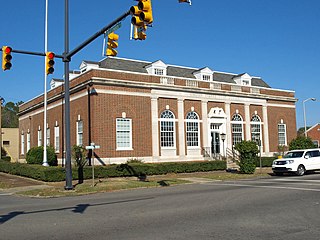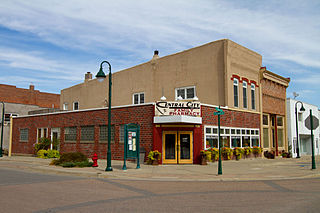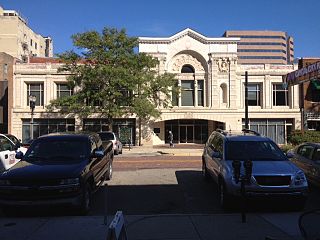
Bowman Field is a public airport five miles (8.0 km) southeast of downtown Louisville, in Jefferson County, Kentucky. The airport covers 426 acres (172 ha) and has two runways. The FAA calls it a reliever airport for nearby Louisville International Airport.

West Vernor–Junction Historic District is a commercial historic district located along West Vernor Highway between Lansing and Cavalry in Detroit, Michigan. The district includes 160 acres (0.65 km2) and 44 buildings. The district was listed on the National Register of Historic Places in 2002.

Tifton Commercial Historic District, in Tifton in Tift County, Georgia, is a historic district that was listed on the National Register of Historic Places (NRHP) in 1986 and expanded in 1994. The original listing was portions of 10 blocks including buildings from the 1890s to the late 1930s, most built of brick.

The Avalon Theater is a Historic Art Deco style Movie theater located in the commercial district of Larimore, North Dakota, United States. Built in 1938 as a 350-seat theater, the Avalon's most significant feature is its Art Deco detailing, especially the marquee, box office, and entry doors and continuing with simple Art Deco geometry motifs in the interior, all of which has survived. The building is constructed of brick with a parabolic poured concrete floor in the seating area to ensure a good view for all. The building still functions as a movie theater, with its original projectors, and also is home to local live theater groups.

The Lincoln Theatre, also known as Little Theatre on Lincoln Street, is a historic performance space at 1 Lincoln Street in New Haven, Connecticut. Built in 1924, it is the only known survivor in the state of the Little Theatre Movement of 1911-1933. The building was listed on the National Register of Historic Places in 1984. After a major rehabilitation in the 2010s, the theater was reopened, and is now known as the ACES Little Theatre.

The Mississippi Lofts and Adler Theatre is an apartment building and theater complex located in downtown Davenport, Iowa, United States. It is individually listed on the National Register of Historic Places by its original name, the Hotel Mississippi-RKO Orpheum Theater. The Hotel Mississippi was listed on the Davenport Register of Historic Properties in 2005. In 2020 the complex was included as a contributing property in the Davenport Downtown Commercial Historic District.

The Post Office Historic District is a historic district in Greenville, Alabama at 100–115 West Commerce and 101 East Commerce Streets. It was listed on the National Register of Historic Places in 1986 and includes Early Commercial architecture, Classical Revival architecture, and Art Deco architecture in its nine contributing buildings.

The Central City Commercial Historic District is a nationally recognized historic district located in Central City, Iowa, United States. It was listed on the National Register of Historic Places in 2003. At the time of its nomination it consisted of 27 resources, which included 18 contributing buildings, one contributing object, and eight non-contributing buildings. The historic district exemplifies the importance transportation played in the development of the central business district.

Gen. John F. Reynolds School is a historic school building located in the North Central neighborhood of Philadelphia, Pennsylvania. It was designed by Irwin T. Catharine and built in 1925–1926. It is a four-story, 12-bay by 3-bay, brick building on a raised basement in the Art Deco-style. It has a one-story addition on the eastern side built in 1958. It features an entrance with Doric order columns and decorative terra cotta panels. It was named for Civil War General John F. Reynolds (1820–1863).

The Malek Theatre, also known as The Malek, is an Art Deco theatre in downtown Independence, Iowa that was built in 1947. It replaced the Grand Theatre, which had burned on March 3, 1945. It was designed by Wetherell & Harrison for Bob C. Malek and was intended to be fireproof. It has a steel truss roof. A stepped tower at the front is made with structural glass and glass blocks. As of 2009 the interior was mostly original, with Art Deco style light fixtures and coved ceilings. Artist Merle Reed, of California, hand-painted its interior designs in 1945.

The Centralia Commercial Historic District is a historic commercial district comprising several blocks of Broadway in downtown Centralia, Illinois. The district includes 57 contributing buildings as well as a historic water tower and sign. Centralia's business district developed around the Illinois Central Railroad tracks, as the town was established by and named for the railroad. The earliest buildings in the district date from the 1850s, as the city was platted in 1853. Centralia's first commercial buildings were mainly designed in the Italianate style, which was predominant until the end of the 19th century; the Romanesque Revival style also gained popularity in the 1880s. Around the turn of the century, the Commercial style became the most popular style in the district. The Renaissance Revival and Classical Revival styles can also be seen in buildings from this era, and by the 1930s Art Deco and Modernist architecture became popular.

The Varsity Theatre is a historic movie theater in Martin, Tennessee, USA. The building is listed on the National Register of Historic Places.

The Florence Downtown Historic District is a historic district in Florence, Alabama. Florence was founded in 1818 by the Cypress Land Company, who counted among its trustees Creek War General John Coffee, future Governor of Alabama Thomas Bibb, early Huntsville settler LeRoy Pope, and future United States Senator and Supreme Court Justice John McKinley. The company hired Italian surveyor Ferdinand Sannoner, who divided the land into over 400 lots and named the town after Florence, Italy. The first Lauderdale County Courthouse was completed in 1822, and the oldest extant building in the district, the Gothic Revival First Presbyterian Church, was completed two years later. Most of the early buildings was destroyed by a fire in 1866. Development resumed in earnest in the 1880s as Florence's industrial economy developed with the addition of several cotton mills, and the Florence Wagon Works, among others. Other booms occurred in the 1920s with the construction of Wilson Dam, the establishment of the Tennessee Valley Authority in the 1930s, and during World War II as metals and chemical plants were drawn to the area.

The Macomb Courthouse Square Historic District is a historic district located in downtown Macomb, Illinois. The district covers six full and four partial city blocks and includes 65 contributing buildings. The McDonough County Courthouse, an 1871 Second Empire building, is the centerpiece of the district. The courthouse is situated in the middle of a Harrisonburg-style courthouse square, which is flanked by two north-south streets and intersected by a single east-west street that splits around the courthouse; the layout is unusual in Illinois, though Stark County has a similar layout. The surrounding buildings are mainly commercial, though several are government buildings. Brick commercial blocks, often with Italianate or Queen Anne details, dominate the district's architectural landscape; the district's more modern buildings, which date to the first half of the twentieth century, mostly have Art Deco or Moderne styling.

Plymouth Downtown Historic District is a national historic district located in Plymouth, Marshall County, Indiana, United States. The district encompasses 47 contributing buildings and one contributing structure in the central business district of Plymouth. It developed between about 1870 and 1940, and includes examples of Italianate, Romanesque Revival, and Colonial Revival style architecture. Located in the district is the separately listed Plymouth Fire Station. Other notable buildings include the Montgomery Ward Building (1929), Metsker Block, Rentschler Building (1910), Early Plymouth Post Office (1884), First National Bank-Plymouth City Hall, Packard Bank Block (1879), Simons Building (1895), Wheeler Block, Bank Block, Bank Block-Masonic Temple (1901), Plymouth Post Office (1935), and Plymouth Motor Sales (1929).

Rushville Commercial Historic District is a national historic district located at Rushville, Rush County, Indiana. The district encompasses 54 contributing buildings in the central business district of Rushville. The district developed between about 1847 and 1940 and includes notable examples of Greek Revival, Italianate, Romanesque Revival, Classical Revival, Collegiate Gothic, Commercial style, and Art Deco style architecture. Located in the district are the separately listed Durbin Hotel, Melodeon Hall, and Rush County Courthouse. Other notable buildings include the former Methodist Episcopal Church (1847-1850), Church of Christ / Boys' and Girls' Club (1850-1853), Beher-King Block (1883), Presbyterian Church (1892-1893), Rushville National Bank (1911), Phoenix Lodge (1913–1915), Rushville Public Library, and former Castle Theatre (1939).

The Lansing Main Street Historic District is a nationally recognized historic district located in Lansing, Iowa, United States. It was listed on the National Register of Historic Places in 2014. At the time of its nomination the district consisted of 51 resources, including 42 contributing buildings, 8 non-contributing buildings, and one non-contributing site. The district covers most of the central business district, which is generally along Main Street. The commercial buildings are mostly masonry structures constructed with bricks or native limestone. A few buildings are frame construction with gable roofs. The buildings are from one to three stories in height, although most are no taller that two stories. The Italianate architectural style dominates. Most of the upper stories in the buildings housed retail or office space, but a few were residential. The commercial buildings that did not house retail establishments were located near the Mississippi River and were industrial in nature. The G. Kerndt & Brothers Office Block (1861) and the G. Kerndt and Brothers Elevator and Warehouses, No. 11, No.12 and No. 13 (1868) are individually listed on the National Register. Three public buildings are located in the district: the former jail and fire station, the Art Deco former City Hall (1938), and the modern U.S. Post Office.

Rodgers Theatre Building is a historic commercial building located at Poplar Bluff, Butler County, Missouri. It was built in 1949, and is a three-story, brick and concrete commercial building with Art Deco and Art Moderne stylistic elements. The building contains a drama stage and one commercial space and consists of three main sections; the facade and theatre marquee, the theatre, and the office block. The theatre marquee features a prominent ziggurat tower. The Stage Company is currently using the historic Rodgers Theatre for several stage productions per year.

The Mount Pleasant Downtown Historic District is a commercial historic district roughly bounded by Mosher, Franklin, Illinois and Washington Streets in Mount Pleasant, Michigan. It was listed on the National Register of Historic Places in 2014.

The Strand Theatre and Arcade, also known as the Michigan Theatre and Arcade, is a former theatre building located at 211–219 South Washington Avenue in Lansing, Michigan. It was listed on the National Register of Historic Places in 1980.






















